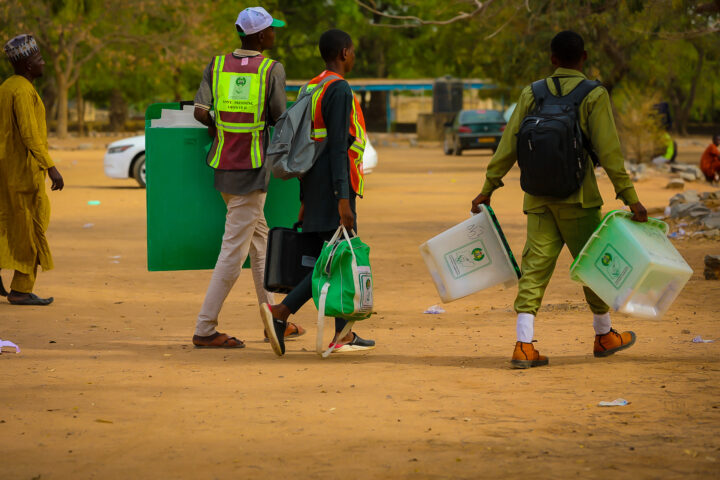BY WAHAB SHITTU
The permeation of technology in the lives of people stems from its dilution of the complications faced by people in their day-to-day lives. This impact is noticeably felt in human communication as the timeframe within which messages are sent and received has been made seamless and swift irrespective of the distance between the sender and the receiver.
Nigeria is not stuck in the unknown of the impact of technology, as it has infiltrated various sectors of the country. The latest attempt at infiltration is recognised in the election process of Nigeria, particularly as it is to be used as a means of transmitting results from various locations in the country to a known centre. The electoral body in the exercise of its discretion through its regulation adopted the electronic means of transmitting the result of the election.
Such information or data is accessed for accountability at a speed necessary to create a watertight defence from the manipulation of results. However, uncertainty beclouds the legal position on the extent involved in the applicability of the transfer of such election results through electronic means, most especially the impact on the manual transmission and other means of transfer of such election results.
Advertisement
Nature of the electronic transmission
The electronic transmission of election results was introduced by the Independent National Electoral Commission (INEC) which is an independent body saddled with the responsibility of conducting elections. The establishment of the body is validly founded on the provisions of Section 153(1)(f) of the Constitution of the Federal Republic of Nigeria 1999 (CFRN) thus giving legality to their existence. The INEC is vested with diverse power under Section 153(2) of the CFRN 1999 and such powers are itemised under item 15 of part 1 to the 3rd schedule.
Some of these responsibilities include the undertaking and supervision of elections, registering political parties monitoring political campaigns in the election amongst others. Under the item, the INEC is also obligated to carry out responsibilities imposed on it as well as exercise powers conferred on it by the act of the National Assembly. The National Assembly in the exercise of its own powers enacted the Electoral Act of 2022 and it was signed into law by the president on February 25, 2022. The CFRN 1999 by the provisions of Section 160(1) empowers the INEC to create its own regulations to direct its actions; this provision is sui generis in nature as it makes the regulations valid without its subjection to the approval or control of the president. This provision recognizes the influence the president’s approval can have on the independence of the body. The Electoral Act 2022 also recognizes this authority as the provision of Section 148 of the act dictates that certain actions are left to the manner which will be provided by the Commission. The exercise of this power led to the creation of the INEC Regulations and Guidelines for the Conduct of Election, 2022. The INEC regulation further asserted their discretion on the manner in which elections will be conducted; birthing Clause 38 in the regulation which introduced electronic transmission of election results.
Advertisement
The regulation holds the status of subsidiary legislation as it was born from the primary lawmaking responsibility of the legislature which had delegated its power to the body. Any action in defiance of the regulation by those bound by it is therefore unlawful as the regulation carries the same weight and force as the law empowering it. The court in the case of Best Njoku v. Chief Mike Iheanatu held that a subsidiary legislation is one that is subsequently made pursuant to the powers conferred by the principal legislation to which it is complimentary; it has the force of law. Therefore, it raises no question as to the validity of the power of INEC to make rules to regulate its own procedures, save for where the regulations made contest with the purports of the constitution or the Electoral Act empowering it; where the latter occurs, it is null and void. The electronic transmission of election results by virtue of being in the INEC regulation receives the force of the law.
Nigeria’s journey to the inclusion of electronic means of transmitting results in the election process began with the Electoral Act Amendment Bill 2021 which resulted in the Electoral Act of 2022. Clause 52 of the bill sought to introduce electronic voting into the election process. Such was meant to be carried out by INEC where practicable, which consequently meant that the manual process was employed where the electronic voting was impracticable. However, the clause failed to reach the last stage of the legislative process as it was amended with only the electronic transmission retained at the exercise of INEC discretion in the INEC regulation.
The electronic transmission of results in Clause 38 of the INEC Regulation is an exercise of the discretion given under Section 60(5) of the Electoral Act, which enumerates that the presiding officer at the polling unit after counting votes and declaring the number is to transmit the result in accordance with the directives of the Commission. With the directives of the commission as to the manner of the transmission, the presiding officer’s disobedience to such attracts sanctions. While Section 60(6) of the Electoral Act fails to expressly include that the sanction also pertains to the disobedience of the presiding officer to observe the provisions of Clause 38 of the INEC regulation, it indirectly brings that INEC directive under the ambit of Section 60 through the Section 60(5). The upload of the polling unit result was an avenue to curb electoral malpractice, as it saves the result sheets (EC8A) from being manipulated during collation at the ward. The timely upload of the result sheet eliminates the weakness of the smallest unit of the electoral division being susceptible to manipulation as the human intervention is checked.
The electronic transmission of the result entails the upload of the result to the INEC Result Viewing Portal (IReV). This is to ensure the availability of the result copies from the polling units to INEC. The regulation permits recourse by the electoral body to the electronically transmitted copies where it is inconsistent with the result that is physically collated. The electronic transmission of results is limited to the polling unit as it does not extend to the wards. Thus, the absence of the method during the ward collation does not attract any sanction and the absence of such requirement at the ward collation helps deal with surplusage; this is because the most basic information has already been provided and any further upload at a higher level is not a necessity.
Advertisement
Clause 48 of the INEC Regulation reveals the status of the electronically transmitted election result where incorrectness is identified by the collation officer, with a similar purpose identified under Clause 51 which states that discrepancies in a result submitted by the presiding officer to the ward collation officer will be resolved using the electronic result to identify the source of the discrepancy. The clause states that the result that is electronically transmitted will be employed for the purpose of collation and announcement of the result. Therefore, in a situation of incorrectness or suspicion of manipulation, the electronically transmitted result supersedes other forms of result appearing before the collation officer.
Electronic transmission and other transfers
The Electoral Act 2022 which repealed the Electoral Act 2010 virtue of the provision of Section 151 introduced various changes and its contents accede to the claim that technology is the future. Some notable inclusion highlighting Nigeria’s participation in the technological advancement includes the use of the bi-modal voters’ accreditation system (BVAS) and the electronic mode of transmitting the election results. The electronic transmission of results adopted in the new act is a departure from the old act which was devoid of the electronic transmission of results. The lack of the electronic means of transmitting results was reiterated by the court of appeal in the case of Abubakar & Anor V. INEC & ors, where the court stated that “there is no provision…for transmission of election results electronically either by the use of smart card reader or other means”.
The exercise of the power conferred on the body to make rules guiding its actions birthed the 2022 Regulations, which amongst others provided for the electronic transmission of the results by the presiding officer stated in Clause 38 of the INEC Regulations of 2022. The provision highlights the incorporation of technology for an expeditious transfer of results from diverse locations and also suppresses the occurrence of electoral malpractice.
Advertisement
However, the nascent status of Nigeria in technology which was evidenced in the connection failures when attempting to provide all presidential election results electronically has led to controversy in the interpretation of provisions pertaining to the transfer of election results. A faction holds the position that the manual transfer of results exists as an alternative to the electronic transmission of the result, therefore in a scenario where the electronic transmission of results fails the manual transmission of the result can be employed.
The other faction opines that the electronic transmission of results is without any alternative virtue of the purport of Clause 38, as the manual transmission is highly likely to be affected by malpractice thus giving freedom to the mischief that the regulation intends to curb. The drawback of the latter’s position that electronic transmission is the only means to be used in light of the reality of the technological stage of the country was revealed at the recently concluded Nigeria 2023 presidential election where the attempt at a timely upload of results ended in futility. Therefore, the position of the manual transfer of the result was employed as it was the best practicable action at that point in time. A common stance in both positions is the acceptance of the legality of the electronic transmission of results. This is due to the lawful exercise of the discretion bestowed on the body to make rules guiding their practice.
Advertisement
This difference in the interpretations of the draftsman’s intention emerges from the combinations of words utilized by the draftsman of the INEC Regulation particularly the word “or” as well as the legislators shying away from firmly establishing the position of the technology in transmitting results. Instead, the legislators through the sections in view gave the discretion to the INEC body to establish the method that will be applicable as a mode of transmitting election results. While a draftsman may conceive certainty in his mind, it does not naturally flow that words used will express such certainty; as in the words of Lord Denning M.R.: “The draftsman conceived certainty but brought forth obscurity, sometimes even absurdity”. The court is unavoidably saddled with the responsibility of treading through obscurity to give meaning which reveals the intentions of the draftsman.
Over the years, the court has applied various techniques for interpreting the statutes, with the most basic being the literal interpretation which stems from the unambiguous words used in the statute. The court will only depart from the literal rule in situations where the use of the words is ambiguous, such an example is in the case of R v Eze where the court departed from the ordinary meaning of “or” due to the ambiguity it perpetrated, thus giving “or” a conjunctive meaning as opposed to the disjunctive meaning which is the ordinary meaning. However, there is no need to depart from the disjunctive meaning of ‘or’ as such provision retains no ambiguity as to the introduction of another mode of result transfer, thus making the literal rule the best tool in interpreting the clause.
Advertisement
Also, in acknowledgement of the potential for ambiguity in construing words, the court picks whichever is equitable in light of the surrounding circumstances. In light of the nascent technology status of Nigeria, it is therefore equitable to state that various other means of transfer should be available alongside electronic transmission, as Nigeria’s technology space avails much room for improvement.
The language of Clause 38 only shows that whilst the draftsman intended that technology be entrenched in the election process, where such is not practicable another mode of transfer has to be put to use. This is due to the statement “Electronically transmit or transfer…” as opposed to the statement “electronically transmit or electronically transfer…” The use of “or” in that clause denotes the existence of an alternative. Therefore, it will only amount to overreaching to attach the word “electronically” to the interpretation of the word “transfer” in the process of construing the intentions of the draftsman when the word ‘or’ appears to separate “electronically transmit” from the word “transfer”. Therefore, electronic transfer does not exist to completely rid the manual transmission or other means of transfer of results from existence. Instead, it relegates the manual transmission to the position of an alternative pending the time it will be utilized as the best practicable means.
Advertisement
In support of the existence of the manual transmission of the result, the words of Clause 48 identify a situation where there is no electronic transmission of the election result by the polling unit. The clause provides that INEC requests duplicate hard copies of the election result which will subsequently be employed in the collation of results. The words ‘hard copies’ reveals the existence of an alternative to electronic transmission. This provision took into cognizance the defeat of the position that electronic voting was introduced to permanently replace the manual transmission of election results. The position that election results from polling units which are not transmitted electronically attain the status of invalidity is rendered redundant by the provisions of Clause 48 and 93 of the INEC Regulation. Therefore, the scope of the electronic transmission of results is not absolute as the other provisions of the INEC regulation show that the election results from various polling units transferred in other forms apart from the electronic medium will still be collated and announced.
Also, opinions pursuing the stance that the only means of transmitting the election result is through electronic means fail to lend credence to the holistic approach of interpreting the Act; as such opinion is derived from restrictively (erroneously) reading Clause 38 of the regulation without recourse to clause 48(c) and 93 in the same regulation. The knowledge that Clause 38 is interconnected with Clause 48(c) and 93 will aid in the understanding that the provision of Clause 38(i) which states that “electronically transmit or transfer” does suggest other means of transferring the result of the election as the word “or” takes the position of revealing an alternative. An appreciation of the holistic approach of the Act reveals that the regulation acknowledges other means being used save the electronic means, but it only gives priority to the results sent electronically over other results. Therefore the idea that providing for other means of transferring results gives freedom to the mischief that the draftsman intended to curb fails in substance as the electronic result is conferred with priority in cases of conflict with other results.
Shittu is a Senior Advocate of Nigeria (SAN)
Views expressed by contributors are strictly personal and not of TheCable.
Add a comment






